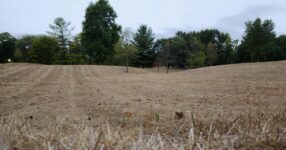
What should you do with your brown lawn this fall? Gardening expert says ‘do nothing’
Ohio State’s Wetlands Research Center off Olentangy River Road is looking a little dry and a little brown – as are parks and lawns all over central Ohio.
Ohio State Extension educator and associate professor Mike Hogan said people have been calling, wondering what to do about their increasingly brown lawns as they head into fall.
His answer: do nothing.
“We’re advising folks to park the spreader, park the mower, leave them in the garage, and really not do anything,” Hogan said.
Fall is typically the best time of year to do a bit of lawncare like reseeding, fertilizing or aeration, but that’s not the case this year, Hogan said.
“The dormant grass – the more that we have any traffic on it, even just walking, human foot traffic, as well as, machinery, lawn mowers, even push mowers. We can really do further damage to the grass,” Hogan said. “Unfortunately, this year, we have to say, let’s stay off the lawn and delay most of our lawn maintenance until soil moisture returns.”
Hogan said that moisture still might return and allow for some late fall lawncare in October and November.
The grass, Hogan said, is not dead, only dormant.
“Most of our turf grasses are cool season grasses, and it’s a normal physiological response for them to go dormant when they don’t have enough water for the plant’s vascular system to function,” Hogan explained. “So, when we get soil moisture returns, most of those plants will green up and should live.”
He added that some plants that were already stressed from disease or insects might not survive the drought, and some sections of dormant lawns might not return to green in the spring.
And some weeds may still be green despite the hot, dry summer. Weed species like crabgrass evolved to survive droughts. The Ohio State University Extension said it’s too late to apply herbicides to weeds, but people can mark areas with weeds to treat in the spring and summer.
As for gardens, Hogan said they shouldn’t require any special care this fall. He said folks can winterize them as normal.
“You know, a lot of folks with gardens are a little better off in that most of us with gardens have a way to irrigate,” Hogan said. “You know, maybe plant a cover crop if you have a way to water that, clean up where you need to, maybe add some old soil amendments, compost.”
Hogan said the good news is that with less lawn care to do this fall, there’s more time to watch Buckeye football.
Copyright 2024 WOSU 89.7 NPR News



